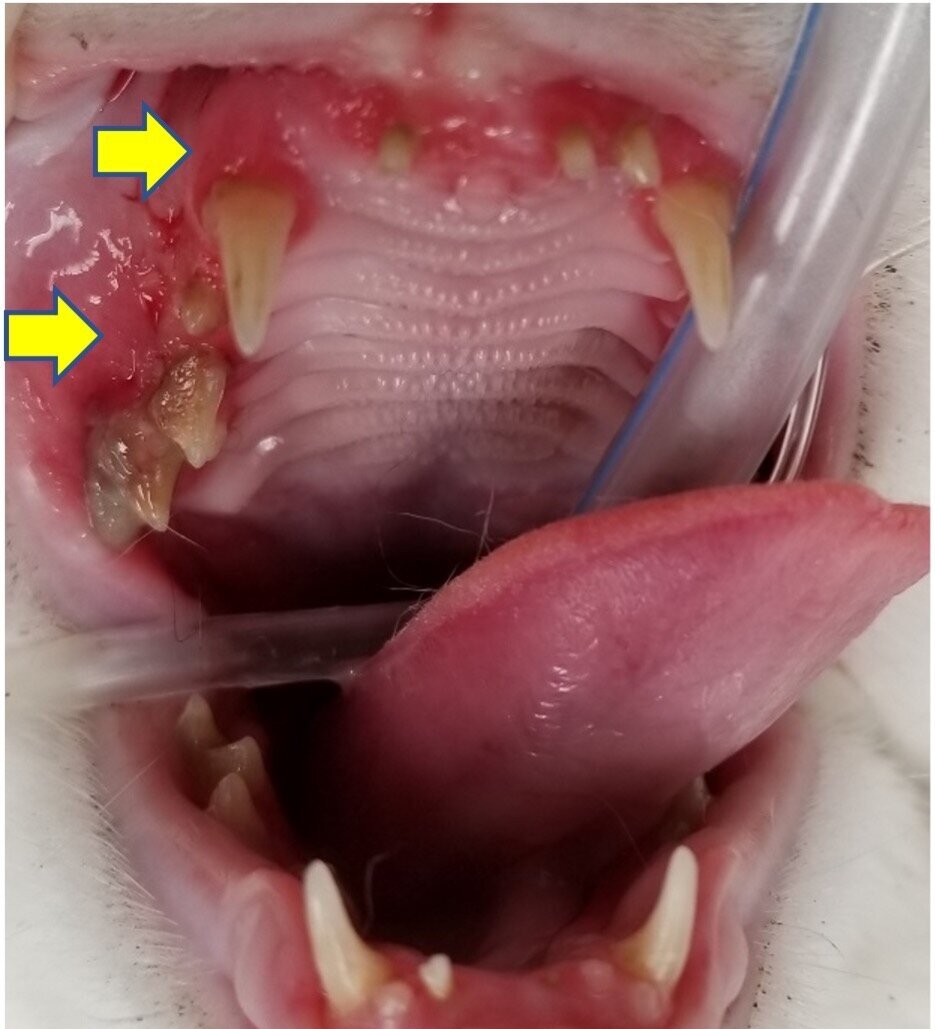Feline Stomatitis
What is feline stomatitis?
Severe stomatitis/inflammation of the gum tissue including the oral mucosa as depicted by the bright red along the gum line (pointed by the yellow arrows). Note that some of the teeth are also covered by heavy tartar/calculus.
Feline gingivostomatitis is a severe, chronic inflammatory disease of the oral cavity that includes the gum tissue (gingiva) and other non-gingival mucosal tissues in the oral cavity (stoma) of a cat.
What causes feline stomatitis?
Unfortunately, the aetiology or cause of this condition remains unknown. The disease is thought to be a multifactorial condition where the host’s immune system is responding inappropriately to chronic antigenic stimulation of various origins. Viral, bacterial, immunologic, and environmental components such as feline leukemia virus (FeLV), feline immunodeficiency virus (FIV), feline herpesvirus (FHV), calicivirus, bartonella, fungal disease, and allergic conditions have been highly suspected to be involved with stomatitis in cats; however, no direct causal relationship has been established with any of these factors. In addition, concurrent dental diseases such as periodontal disease and tooth resorption are also highly suspected to trigger the condition due to bacteria and plaque accumulation.
What are the signs of feline stomatitis?
Clinically, affected cats will often have signs such as oral discomfort, anorexia, ptyalism, halitosis, and unkempt coat due to reluctance to groom. The prevalence of stomatitis in cats is low, ranging from 0.7-12% of the general population. However, the condition can be challenging and frustrating to manage and it is known to be a very painful condition for the affected cats.
Post-operative photograph following full mouth extractions. The multiple dark blue spots are multiple absorbable sutures along the extraction sites. Surgical closure following extractions is paramount for appropriate and efficient healing following this extensive procedure.
How is feline stomatitis treated?
Your primary veterinarian may refer your cat to our Board-Certified Veterinary Dentist at Queensland Veterinary Specialist for a full-mouth or partial mouth extraction once they suspect this condition. It is important for you to understand that the extraction procedure is not 100% curative and may only provide approximately 67% success rate based on previous studies. Further long-term medications (pain relief and/or antibiotic) may still be needed in certain cases that show recurrent oral inflammation. Conservative/medical management alone without any extractions have been shown to be unsuccessful and we do not recommend this option to treat feline stomatitis in our patients.
Patients who receive full or partial mouth extractions at Queensland Veterinary Specialists are usually hospitalized overnight for close monitoring, supportive therapy, and pain management. They receive intravenous fluid administration to keep them hydrated after the surgery and multimodal pain relief throughout their procedure and stay in the hospital. Our 24-hour hospital facility is a Certified Level III Veterinary Emergency and Critical Care Facility, and we offer our gold standard patient care for your pets during their hospital stay.




